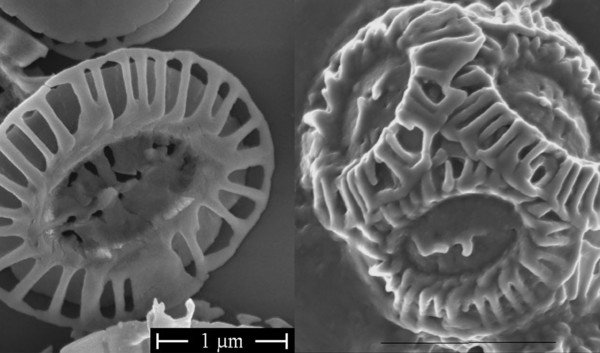
Luminescent Materials Through Living Microalgae
In this project, we aim to incorporate rare earth ions into the calcite coccoliths of Emiliania huxleyi algae via biomineralization processes. In doing this, we want to produce a luminescent, highly-structured micromaterial which glows with a red, green or blue colour. We use, for the first time, living organisms for the generation and shape-forming of components for luminescent technical devices.
Biomineralization is the production of inorganic minerals by living organisms. The marine unicellular algae E. huxleyi produces elaborate calcite shells by biologically controlled mineralization. The shells, called coccoliths, are composed of 30-40 single crystal segments and are generated inside the cell. When a coccolith is complete, it is extruded and arranged outside the cell, so each cell is surrounded by 10-15 coccoliths. These are easily detached, and new ones are constantly being formed. The mechanism of intracellular biomineralization under genetic control allows the accurate replication of the coccoliths, which is important for their use in future devices.
Rare earth elements (REE) show photoluminescence, even when incorporated into different materials, thus REE are widely used activators for luminescent materials. REE are used especially in light generating devices like lasers, color-displays, fluorescent lamps or light-emitting diodes. One advantage of REE is that the emission wavelength is independent from the matrix. Hence, different host lattices can be used and doped with specific REE to produce materials of characteristic colours. Although REE occur mostly as trivalent cations, their coordination properties are very similar to divalent metal ions like Ca2+ [1]. They can replace Ca2+ in biomolecular structures and the biological activity is often retained.
Up to now, there have only been a few reports on accumulation and incorporation of REE in living organisms. Biomass of macroalgae (multicellular organisms) like brown algae and seaweed adsorbs REE [2,3,4]. Also, some unicellular freshwater algae accumulate REE from the surrounding water passively [5,6].
Foraminifera, single-celled protists, include REE, like Eu, in the calcite lattice of their shells [7]. Foraminifera do not transport the ions needed for biomineralization of their shells from the surrounding medium via trans-membrane-transport, but use endocytosis of seawater. Therefore, not single ions, but a ‘portion’ of seawater containing Ca and REE is transported through the membranes [8]. In coccolithophorids (e.g. the here investigated species E. huxleyi), Ca2+ permeable channels and pumps transport the cations needed for CaCO3 biomineralization to the calcifying vesicle [9].
To obtain coccoliths with incorporated REE, building on previous experience [10] we incubate the E. huxleyi cells in media containing salts of Eu, Tb or Tm. We use as a basis the artificial seawater medium ESAW [11], suitable for the cultivation of E. huxleyi, and add different amounts of the REE. In preliminary experiments we successfully developed media with different Tb/Ca ratios and produced coccoliths which showed luminescence with spectra according to terbium. These first results indicate that the E. huxleyi cells incorporate the Tb ions into the coccoliths.
[1] F.S. Richardson, Chemical Reviews 82 (1982) 541-552.
[2] N. Sakamoto et al, Bioinorganic Chemistry and Applications 2008 (2008) 1-8.
[3] Y. Diniz, B. Volesky, Water Research 39 (2005) 239-247.
[4] K. Vijayaraghavan et al, Industrial and Engineering Chemistry Research 49 (2010) 4405-4411.
[5] K. Kawamoto et al, J of Radioanalytical and Nuclear Chemistry 236 (1998) 119-122.
[6] T. Ozaki et al, Environmental Toxicology and Chemistry 22 (2003) 2800-2805.
[7] M.R. Palmer, Earth and Planetary Science Letters 73 (1985) 285-298.
[8] L.J. de Nooijer et al, Biogeosciences 6 (2009) 2669-2675.
[9] N. Gussone et al, Geology 34 (2006) 625-628.
[10] G. Santomauro et al, J Biomat Nanobiotechnol 3 (2012) 362-370.
[11] J.A. Berges et al, J of Phycology 37 (2001) 1138-1145.
This research is carried out in collaboration with researchers from the group of Prof. Dr. J. Bill at the University of Stuttgart.